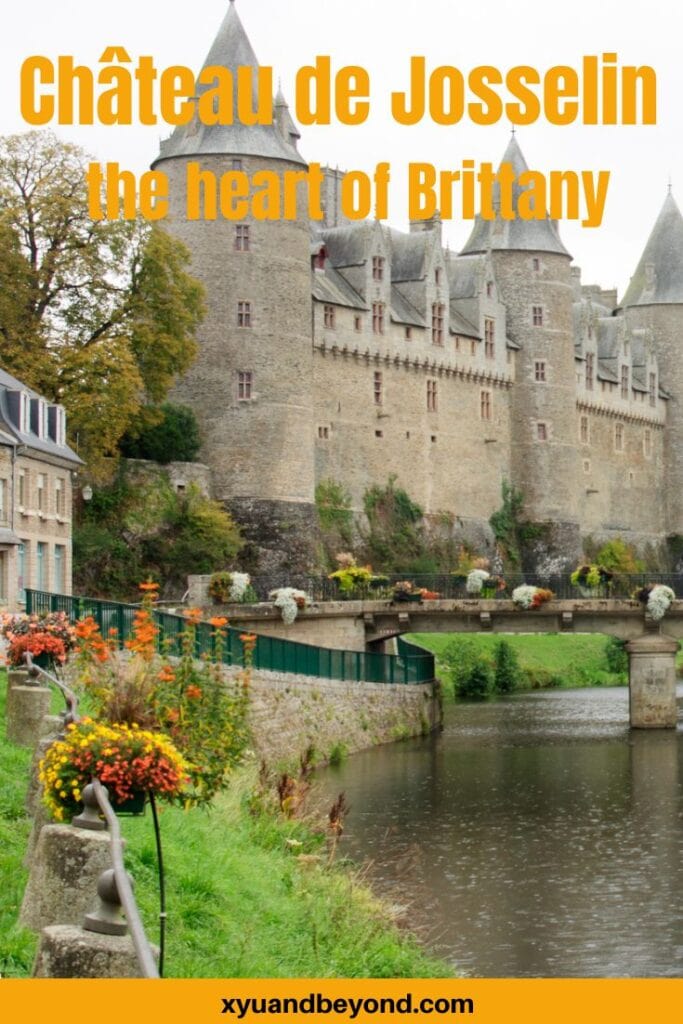Château de Josselin Brittany: 1000 years of French history
Lying on the banks of the River Oust 43km northeast of Vannes in Brittany sits Josselin a Petite Cité de Caractère (small town of character). The town sits in the shadow of the stunningly beautiful Château de Josselin which dominates the entire area. The town now bustles with tourists who are awed by both the medieval town centre and the stunning Josselin Castle.
Josselin Brittany is an easy place to visit, you can park free by the River and wander up the hill to the medieval centre and entrance to the Château de Josselin (Castle Josselin). There are several things to do in Josselin and it is a truly lovely place to simply wander.
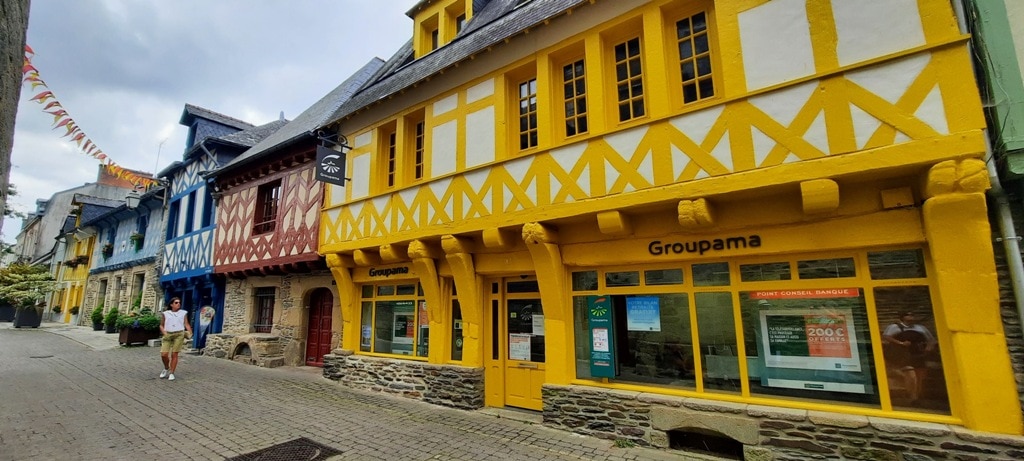
You will find Josselin’s Tourist Centre in the upper part of the old town on rue Georges le Berd. From here you can arrange tours and pick up some brochures in English about the town and the Broceliande area which is apparently where the legends of King Arthur originated.
Xyuandbeyond is reader-supported. When you buy through links on our site, we may earn an affiliate commission. You can read my privacy policy here.
Map of Josselin

History of Josselin
Josselin was founded in the 11th century by the Viscount of Porhoët on this rocky outcrop which gave him a superb defensive position against the many forces ranging against the Bretons. The first Castle and village were destroyed in 1168 by the Plantagenet King Henry II of England but it was rebuilt in the 12th century when a new castle was built on the old foundations. The town was protected by the ramparts and was very prosperous from the 15th to the 18th centuries.
There are many tourist attractions in Josselin including many 16th-century half-timbered buildings and the gargoyled Basilique Notre Dame du Roncier (our Lady of the Brambles) with its beautiful 15th and 16th-century stained glass windows. The Basilica also contains the tomb of Olivier de Clisson, nicknamed ‘The Butcher’ for his tendency to chop the arms and legs off English soldiers in battle.
Olivier V of Clisson was born at the Château de Clisson and died in 1407 at the Château de Josselin. Clisson was a Breton feudal lord and the Count of Porhoët. After his father was hung for treason by the King of France Olivier’s mother made him swear to revenge on his father’s death.
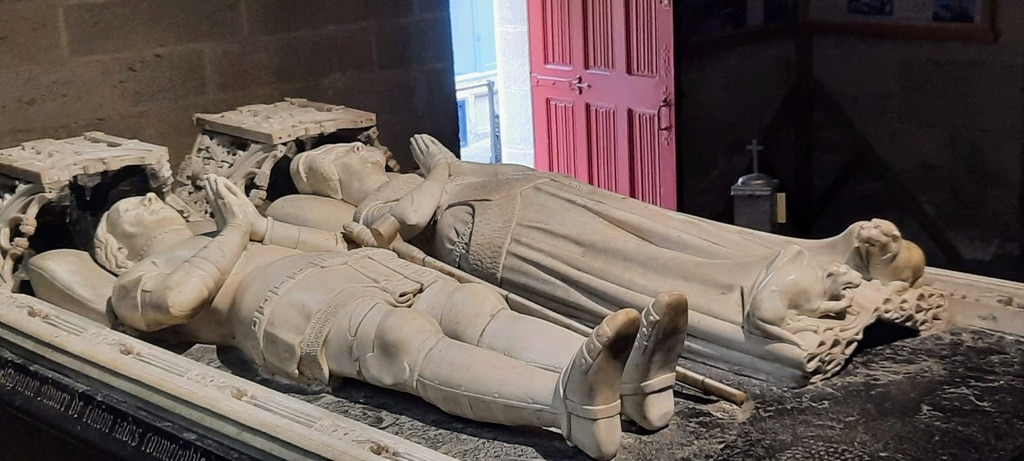
Olivier accompanied his mother to England where he lived in the court of King Edward III. After ten years spent in England, Olivier accompanied Edward III to France in 1359 and leads a war of harassment in Poitou at the head of an English army. In later years Olivier’s father was forgiven for his treasonous acts and Olivier became allied with the French he was also still aligned with the English and fought for both sides. Olivier successfully gained his lands back and continued to fight against the British earning him his nickname of The Butcher as he did not hesitate to chop off enemy arms and legs.
Every Bastille Day (14th July) Josselin re-enacts its historic past with the hugely popular Festival Médiéval when the whole town dresses up in period costume.
Château de Josselin
Josselin Castle has been home to the Rohan family for more than ten centuries the imposing granite le Château de Josselin stands on a rocky esplanade over the Oust Valley beside the Nantes-Brest canal.
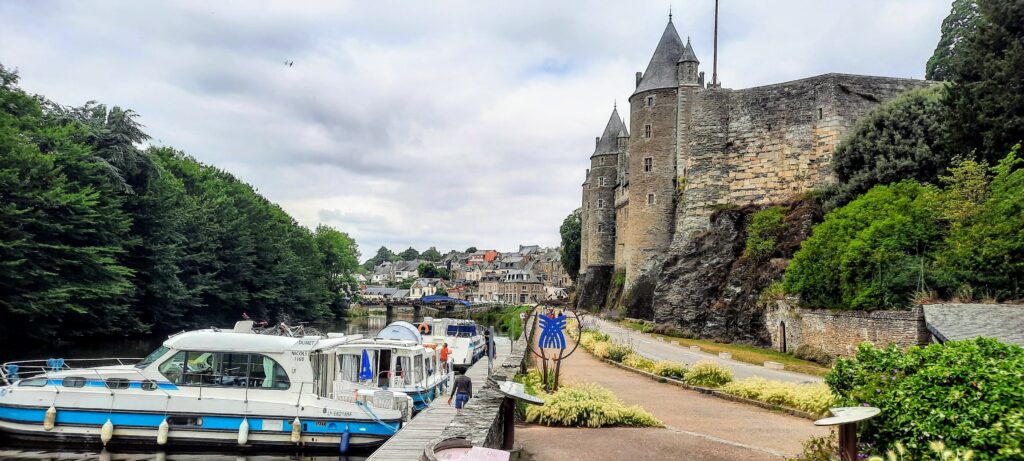
Overlooking the Oust from a rocky esplanade, the walls of the Josselin Chateau is one of the most beautiful castles in Brittany. It is breathtaking when the three towers come into view from the roadside along the canal. Just before the road curves up to head into the medieval centre you will find a parking lot that is free of charge canalside. From here you can walk up the hill to the castle entrance and the medieval centre.
Built in the 11th century by Guéthennoc, Lord of Porhoët, this castle was destroyed for the first time by the formidable King of England Henry II Plantagenêt. It will be rebuilt and fortified in 1370 by its new owner Olivier de Clisson who makes it one of the most powerful fortresses in France with its nine towers and a keep.
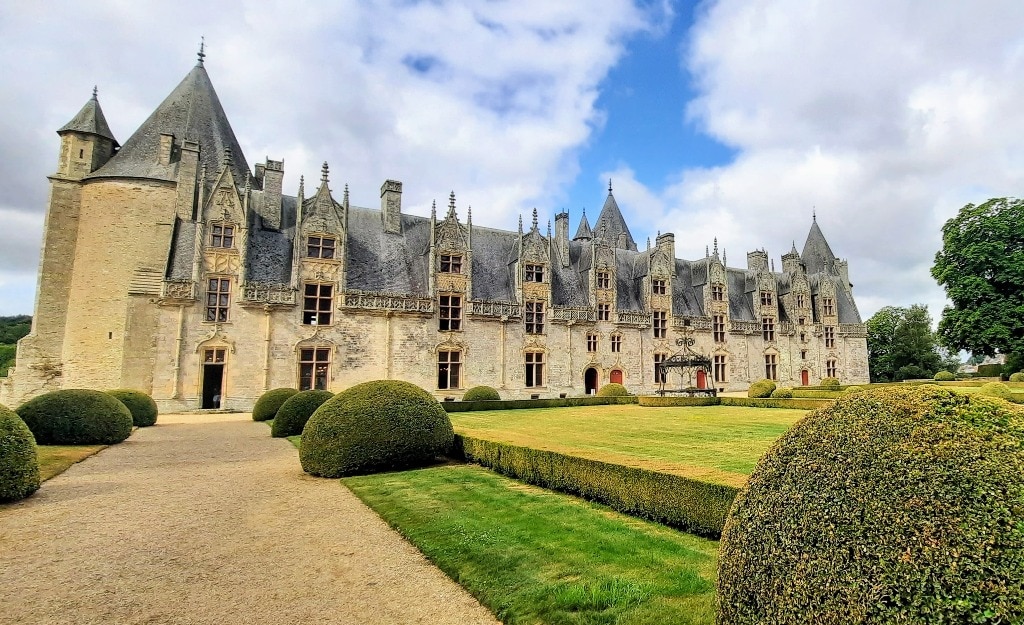
Around 1500, Jean II de Rohan, great-grandson of the powerful Constable of France, added a dwelling with a stunning flamboyant Gothic-style facade. Josselin Castle underwent more trials given the politics and machinations of those in power over the next few hundred years.

It was Cardinal de Richelieu who ordered the destruction of the castle in around 1629. During the Wars of Religion Henri II de Rohan had recently converted to Protestantism and this enraged the Cardinal to protect the Crown and Catholicism he ordered the castle to be destroyed or at the very least reduced in its capacity for war. So using the explosives of the day five of the nine towers were destroyed by the large keep.
Cardinal Richelieu ordered the dismantling of the castle and demolished the keep, as well as three towers. Legend has it that passing the Duke Henri de Rohan in the king’s antechamber, he said to him victoriously: “Monsieur le Duc, I have just thrown a good ball in your bowling game! “

The castle was neglected for more than three centuries by the Rohan family. In the 16th century, because of their conversion to Protestantism, the Rohans were banished from Brittany. In the 17th and 18th centuries, they were established at Château de Blain, in Loire-Atlantique. It wasn’t until 1860 and Charles-Louis Josselin that Josselin castle was again inhabited by the Rohans. It was a mammoth task as the castle itself was uninhabitable with a collapsed roof and nature’s reclamation efforts.
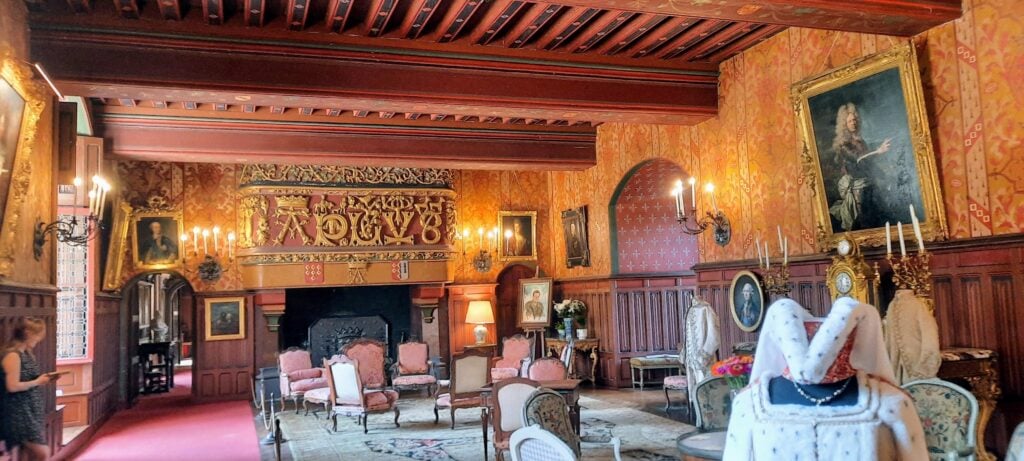
The interior was completely refurbished during the second half of the 19th century by Alain de Rohan, the great-grandfather of the current owner Josselin de Rohan, to make it habitable. Since then, the castle has undergone repair and restoration work every year.
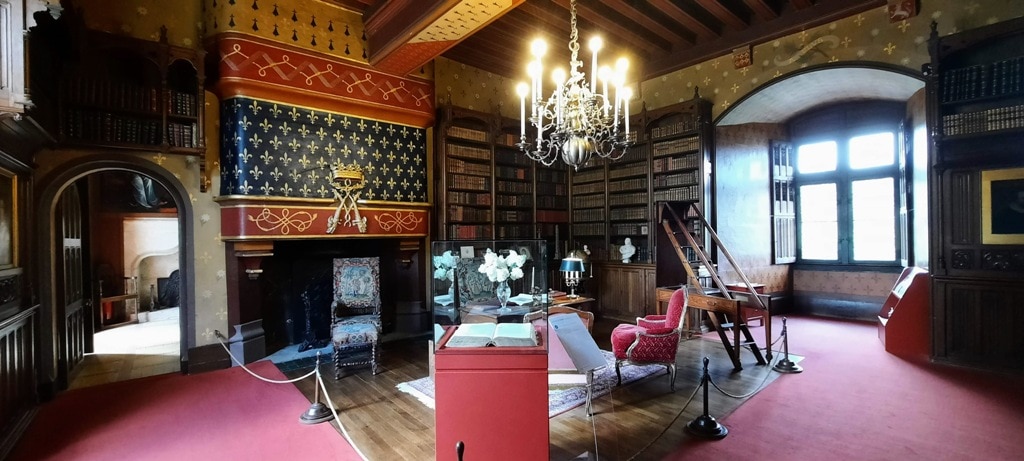
Within the Castle, you will see only the ground floor which comprises around 5 rooms one of which is the portrait gallery. One portrait for some reason caught my eye and it was a painting of Georgine de Serent who was tragically killed (in 1815) when the lace of her dress caught on fire while she was getting ready for dinner. She survived the night horribly burnt with her husband at her side. Her husband never re-married and took holy orders and became an Archbishop.
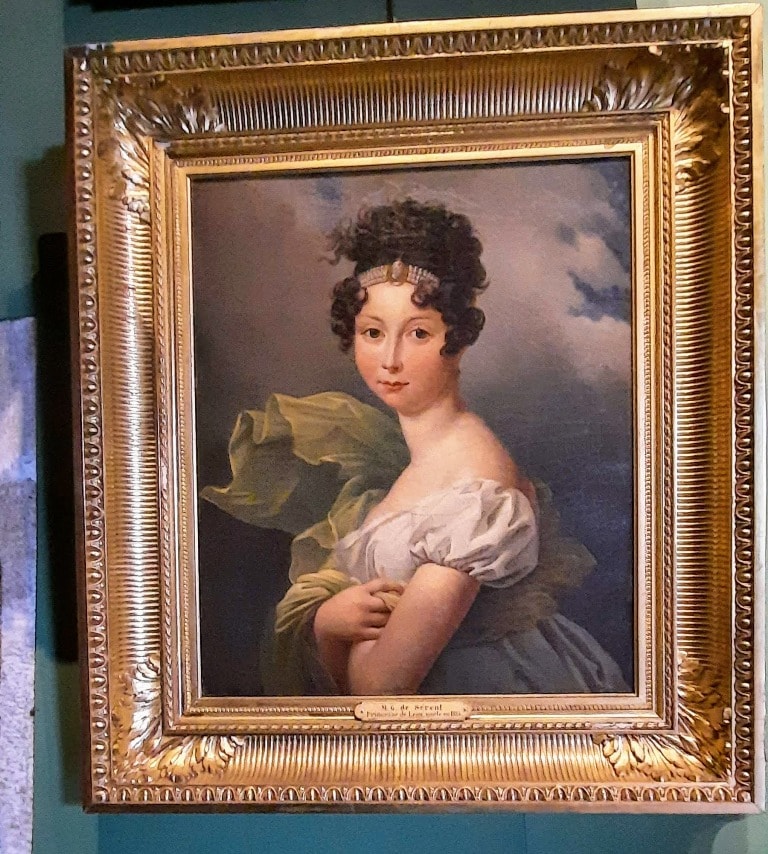
Josselin Castle opening times
The Château is open to the public from April to October with access to many areas including the 19th-century dining room, drawing room with its impressive 16th-century fireplace and library housing more than 3,000 volumes dating from the 17th century.
Guided tours around some of the Chateau’s extravagantly-decorated rooms run from April to September and twice a day the tours are in English. A free self-guided tour of the Chateau is 10,80 € for an adult and 5,50 € for children.
Do you need to book in advance to visit Chateau de Josselin? No, the castle is open to the public now with no booking required.

Within the grounds of the Chateau, you can visit the gardens designed by Achille Duchene in the English style with 160 varieties of roses. In front of the imposing Renaissance façade, the French-style parterres, with their boxwood and trimmed yews, offer a contrast with the English-style garden which stretches out at the foot of the ramparts, visible from the terrace.

In the gardens, you will find azaleas, dogwoods, camellias and rhododendrons under the shade of trees that are more than 100 years old.
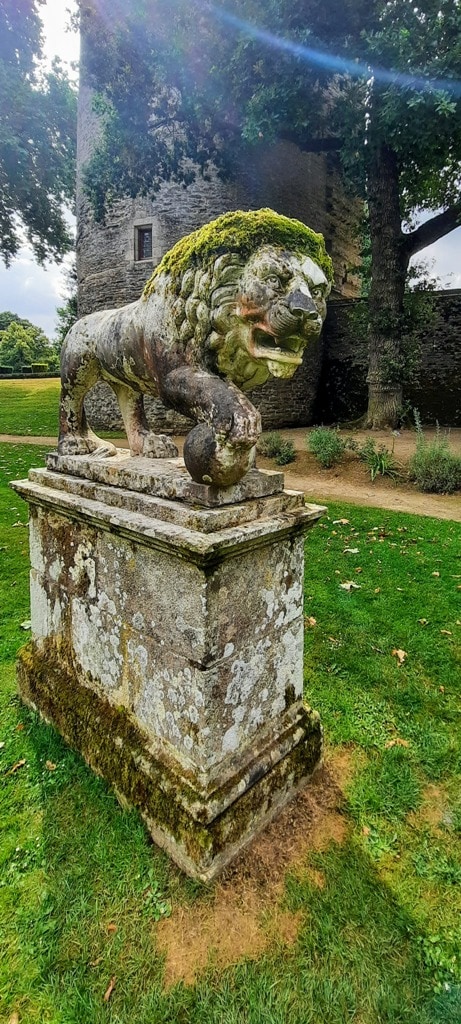
Musée de Poupées (Doll Museum)
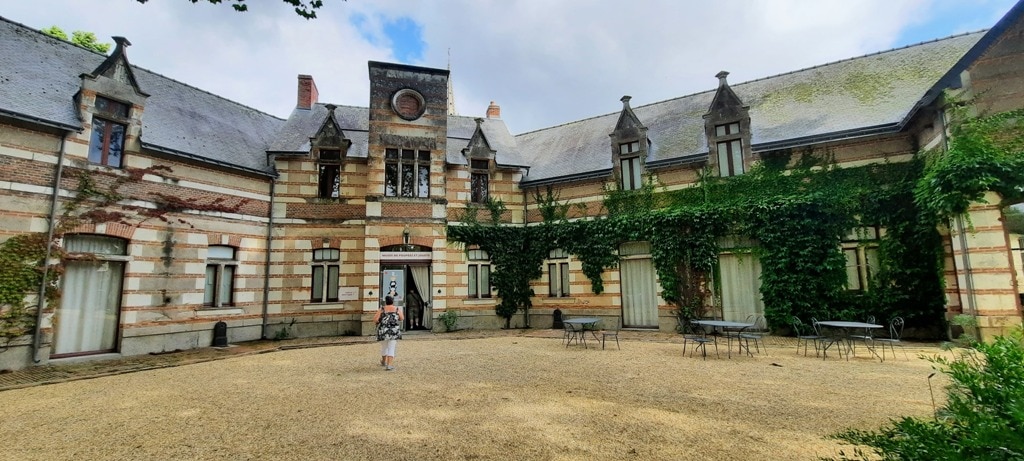
On your way out of the Chateau in the converted stables (and included in your entry fee) is the Musée de la Poupée (Doll’s Museum) which houses a collection of over 3000 antique dolls and dolls’ furniture and 2000 other children’s toys, books and games. These were all collected by the owner’s great-grandmother beginning in the 19th century.
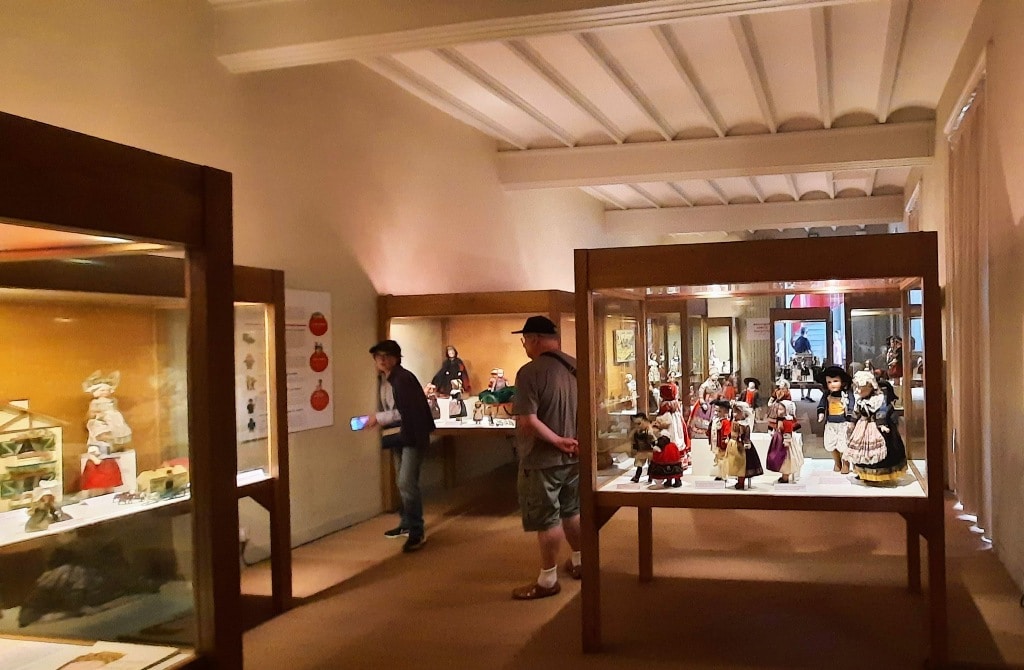
Exiting the Musée de la Poupée you turn to your left and continue back up the hill to the Medieval Town Centre.
13 Things to do in Josselin, France
Spreading up the hill is the cobbled old town with street cafes, Tabac’s, Restaurants and a range of banks and shops (including “The English Bookshop” ). Every Saturday in Josselin the streets are filled with over 80 stalls in the weekly street market where you can buy everything from fresh cheese to live chickens.
Chapel of the Congregation
The Place de la Congrégation is where the entrance to the castle is located. There, the chapel of the Congregation, built in 1702 by the Congregation of the Mission, founded by Saint Vincent de Paul, is to your right. At that time, the bishop of Saint-Malo refused to consecrate it so it was abandoned during the Revolution, it became a granary and during WWII a classroom.
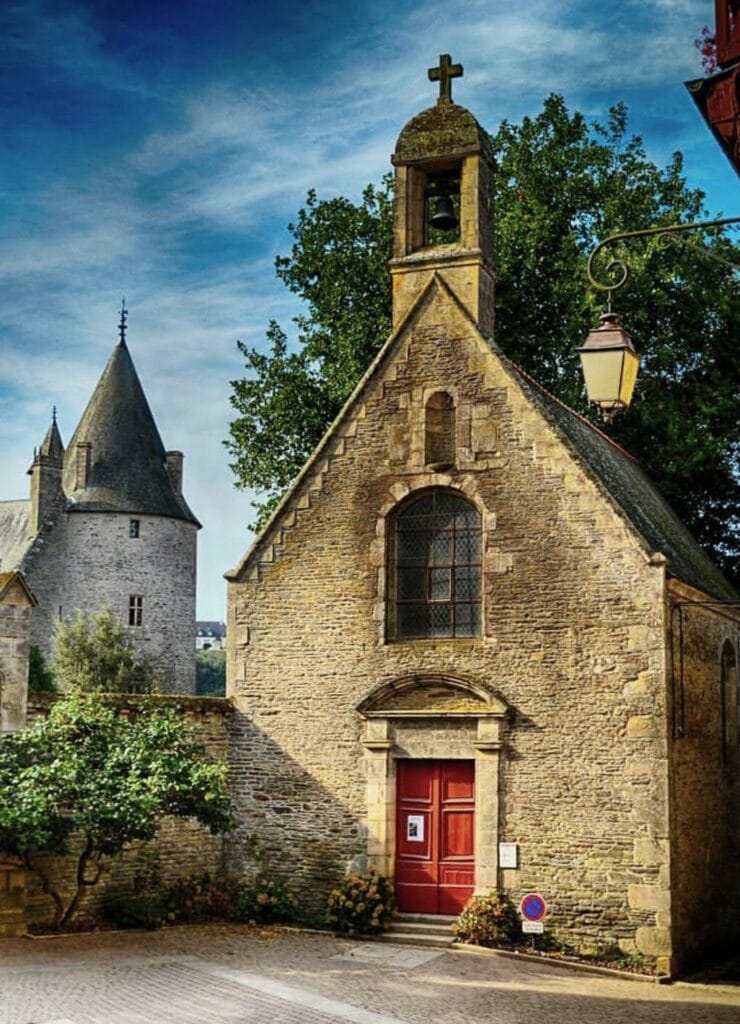
Notre-Dame du Roncier Basilica
The Sainte-Croix district is known for its magnificent half-timbered houses and you will spot the Notre-Dame du Roncier basilica, which was erected in the 11th century and has been remodelled several times, to the flamboyant Gothic style you see today.
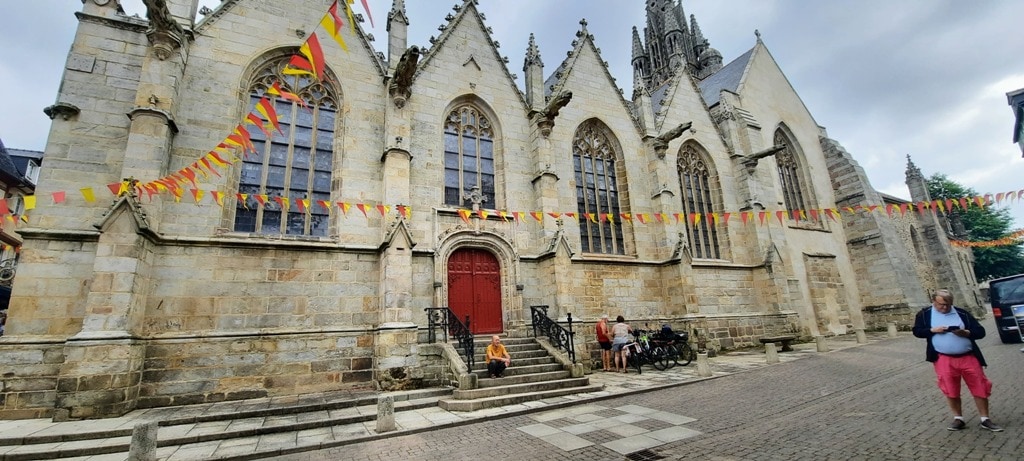
It retains the remains of a primitive Romanesque site in the square of the transept and houses the cenotaph of Olivier de Clisson and Marguerite de Rohan, his wife, a tomb erected in the 15th century by their son-in-law. The reliquary of the miraculous Virgin is kept there as well as the statue of Notre-Dame du Roncier, which is carried during the annual pardon procession.

The most modern part of the Basilique is the 60m tower that was only built in 1949. This modern tower is open to the public and can be climbed for free. You enter the tower by the door off Place de la Mairie.
Half-timbered houses of Josselin
While strolling through the narrow cobbled streets of Josselin, you can admire the many half-timbered houses, the oldest dating from 1538 in the old centre.
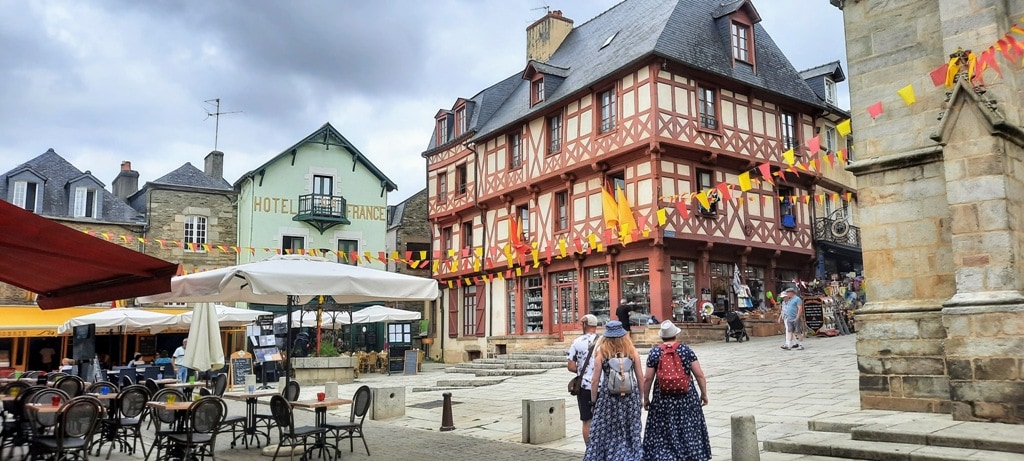
Medieval Garden
Josselin Town Council has developed a hidden courtyard into a medieval garden, right in the centre of town. If you follow the passage down the side of the Hotel de France you will find it. Traditional French vegetables, fruit and herbs are grown alongside roses, with some nice seating areas. Worth a quick detour off the main square when shopping in town.
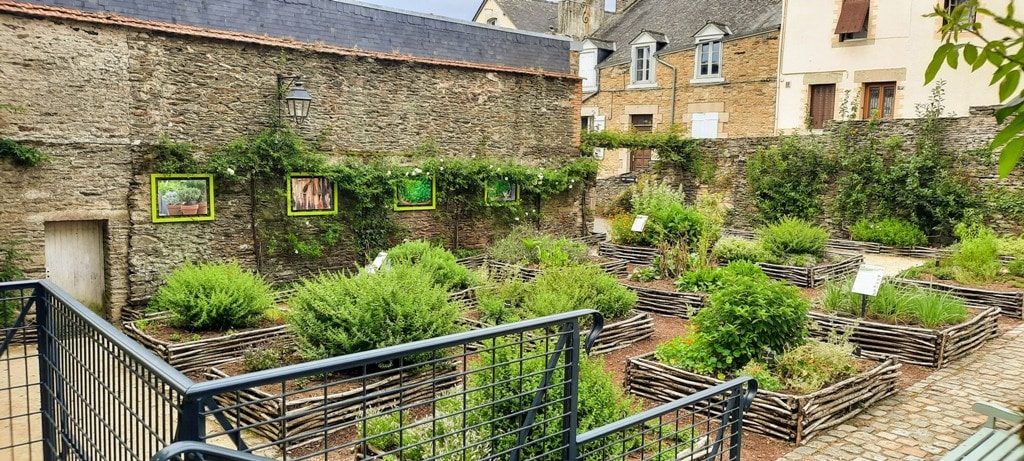
Maison des Porches
The house is found on the Rue Olivier-de-Clisson and was built in the course of the 16th century and listed as a Historical Monument of France.
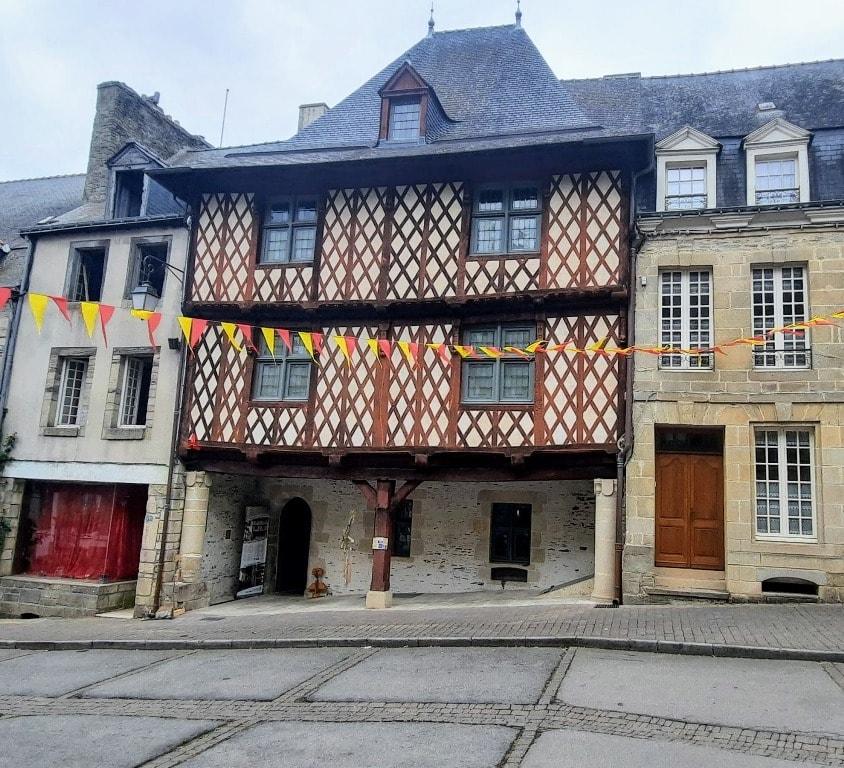
Sainte-Croix District
This part of the Heritage trail is across the canal from Chateau Josselin the walkway bridge provides outstanding views of the castle and the area was restored in 2006, the Sainte-Croix district is as old as the castle. Built around the charming chapel of the same name, it contains fine examples of half-timbered houses.

Lavoir en contrebas du Chateau
At the foot of the castle, lies the washhouse built at the end of the 19th century there is a 6-minute soundtrack here that tells the legend of the washerwomen who were doing laundry one day with their dogs beside them when a beggar woman appeared and asked for alms.
In response, the women send their dogs to hunt her. As they approach the beggar she removed her hood and transforms into the Virgin Mary. To punish the women for their gesture, she condemns them, as well as their descendants, to bark like dogs

Electric Boat Rental
Just across from the Washhouse, you can rent an electric boat to take a trip down the Canal. Located in Josselin’s river port, at the bottom of the chateau, Ti war An Dour offers to rent electric boats. Two types of boats are available: the ACE with a carrying capacity of 5 persons and the SCOOP with a carrying capacity of 7 persons. The boats are equipped with silent engines and very easy to use while you enjoy a peaceful sail on the canal.
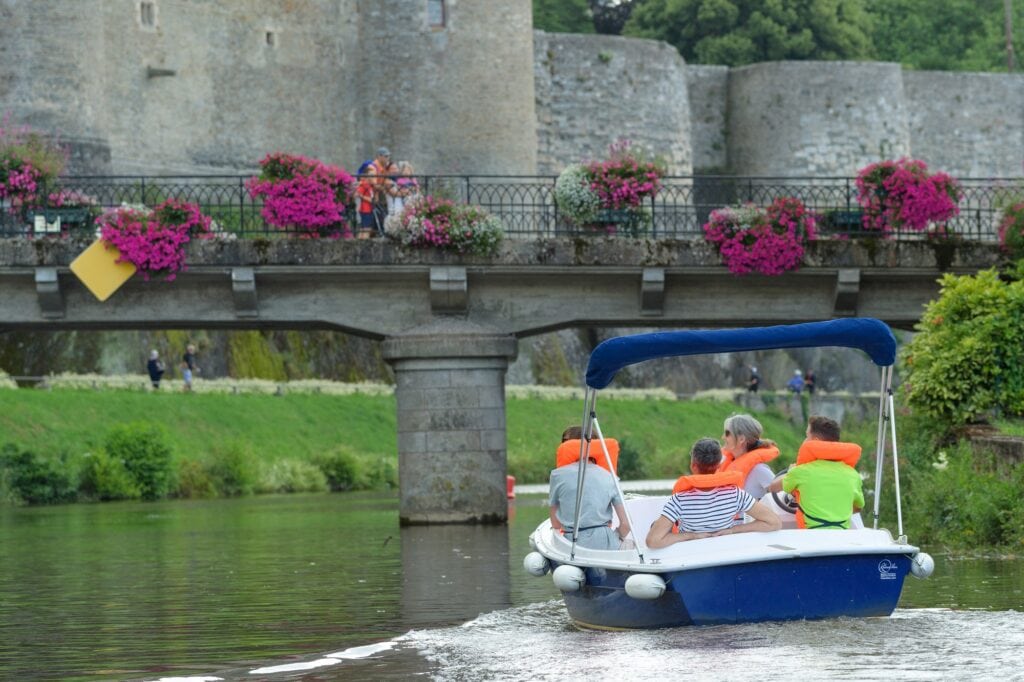
Sainte-Croix Chapel
Located in the upper district of Sainte-Croix, this Romanesque chapel is one of the last vestiges of a former priory founded around 1050. From the 15th century until the Revolution, this chapel served as the church for the parish of Sainte-Croix. In the adjoining cemetery stands a four-sided Calvary cross (dated 15th century). The Chapel is registered as a Historical Monument of France.
In 1092, Anne de Léon, Viscountess of Porhoët was buried there in the presence of three bishops, five abbots and many nobles.
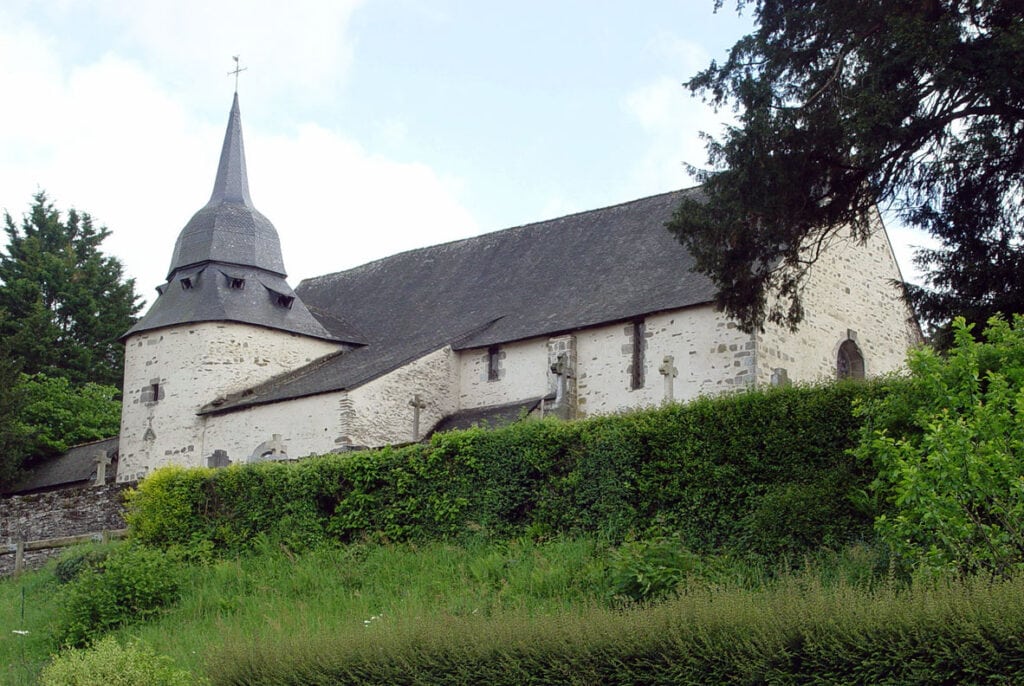
Market Day in Josselin
Saturday is market day in Josselin and runs every Saturday from 8 am to 1 pm. The streets in the city centre are closed to traffic the market goes down the hill toward the Château and towards Canal de Nantes à Brest and has stalls selling fresh fruit and vegetables, housewares, clothes, hot roast chickens, plants and Breton cider.

Bois d’Amour – Lover’s Wood
If you follow the Bois d’Amour et Circuit from the parking lot by the canal you will end up at a pretty and very peaceful park of over 6 hectares. From the canal, you will pass by the Lavoir en contrebas where the townfolk came to have their laundry done.

Within the park, there is a rhododendron conservatory, a bamboo grove and the Notre-Dame-du-Roncier Fountain. The fountain is dated 1675 but believed to be much earlier. The site was founded when a farmer recovered a statue of the Virgin in a bramble tree. Legend says that if the statue is removed it will find its way home to the fountain.
The fountain is reputed to have miraculous healings and cure epilepsy and every September a ‘Pardon’ is held. This is a form of pilgrimage in Brittany that is organized yearly and includes a mass and an outdoor procession to this sacred place. The fountain has been listed as a historical monument since 1928.

Hotels in Josselin
Hotel Restaurant du Chateau – Directly across from the Castle this hotel situated on the banks of the River Oust is very handily located and has a superb restaurant.
The restaurant serves authentic local cuisine in the medieval dining room with a fireplace. In summer, it is possible to dine on the terrace and enjoy a panoramic view of the castle and the river. Additional facilities at the Hôtel-Restaurant du Château include an English-style pub and free on-site parking.

So there you have my top 11 things to do in Josselin France and a little history of the town and why it’s included as one of Brittany’s small towns of character. If unique towns, interesting history and travel tips in France interest you, then you might like to read our other posts below.
Food in Brittany: Fall in love with the food of Bretagne
Visiting Fougères France – City of Art and History
The Ultimate guide to visiting Rennes France
14 Fabulous Castles of the Loire Valley
Saumur France the pearl of the Anjou
Exploring the beautiful Mayenne – Pays de la Loire, France
Beautiful villages in Normandy
How to spend a beautiful day in St. Malo Brittany
Granville France –childhood home of Christian Dior
Cancale the charming oyster capital of France
pin it to save it
